Health Policy Brief: National Oral Health Plan Analysis
VerifiedAdded on 2022/11/10
|14
|3304
|261
Report
AI Summary
This health policy brief critically analyzes Australia's National Oral Health Plan 2015–2024, evaluating its significance in reducing the burden of oral disease and associated costs. The brief highlights the prevalence of oral health issues, including untreated tooth decay, low rates of dental visits, and disparities among Aboriginal and Torres Strait Islander populations and those with lower socioeconomic status. It identifies challenges such as staff recruitment in remote areas, funding limitations, and cultural sensitivity in service delivery. The brief supports the continuation of the policy, recommending strengthened health insurance coverage and increased cross-cultural education to improve oral health outcomes in Australia. The analysis also discusses the importance of government involvement, stakeholder engagement, and potential interventions like Medicare claiming and culturally appropriate health education to address the identified challenges and achieve the plan's goals.
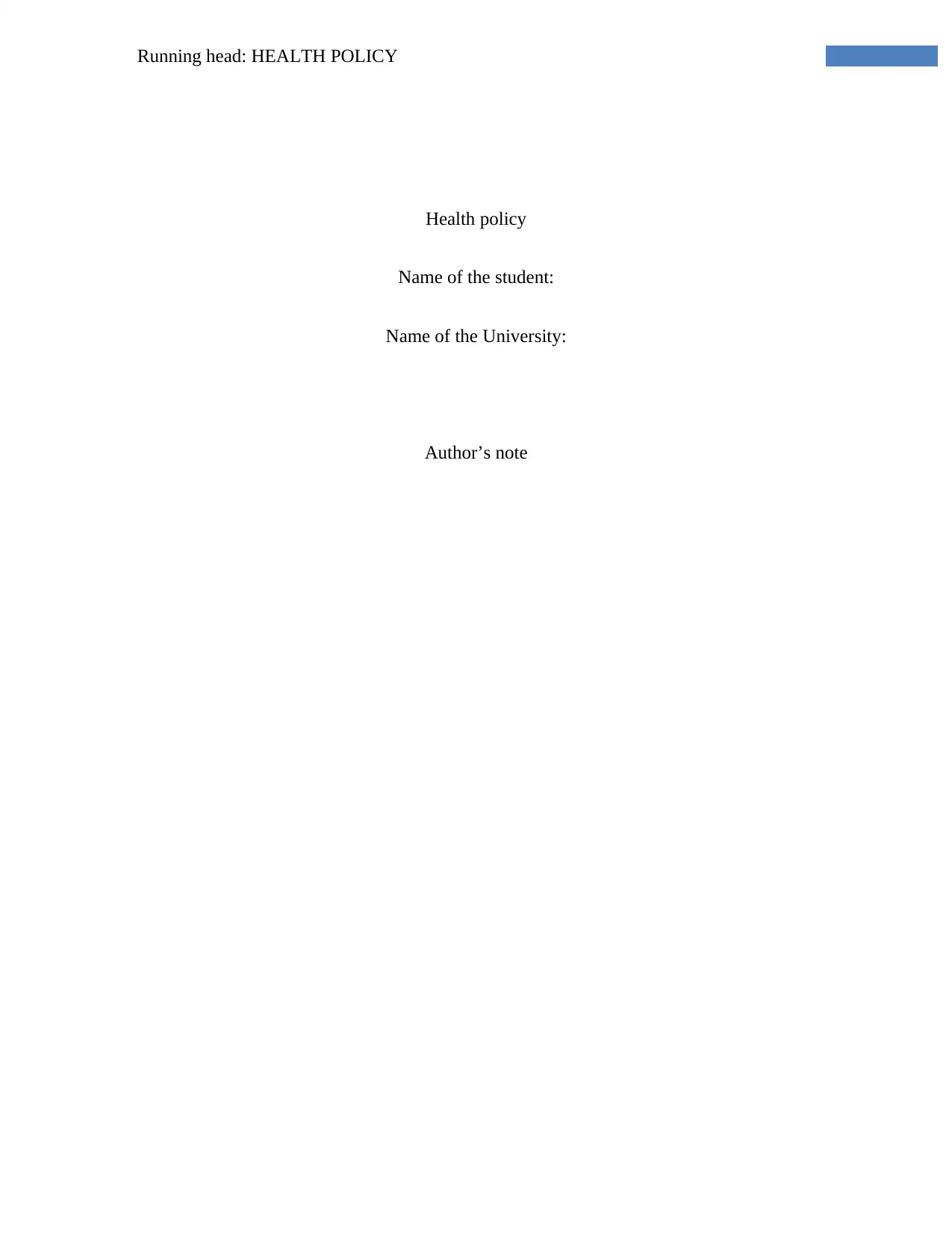
Running head: HEALTH POLICY
Health policy
Name of the student:
Name of the University:
Author’s note
Health policy
Name of the student:
Name of the University:
Author’s note
Paraphrase This Document
Need a fresh take? Get an instant paraphrase of this document with our AI Paraphraser
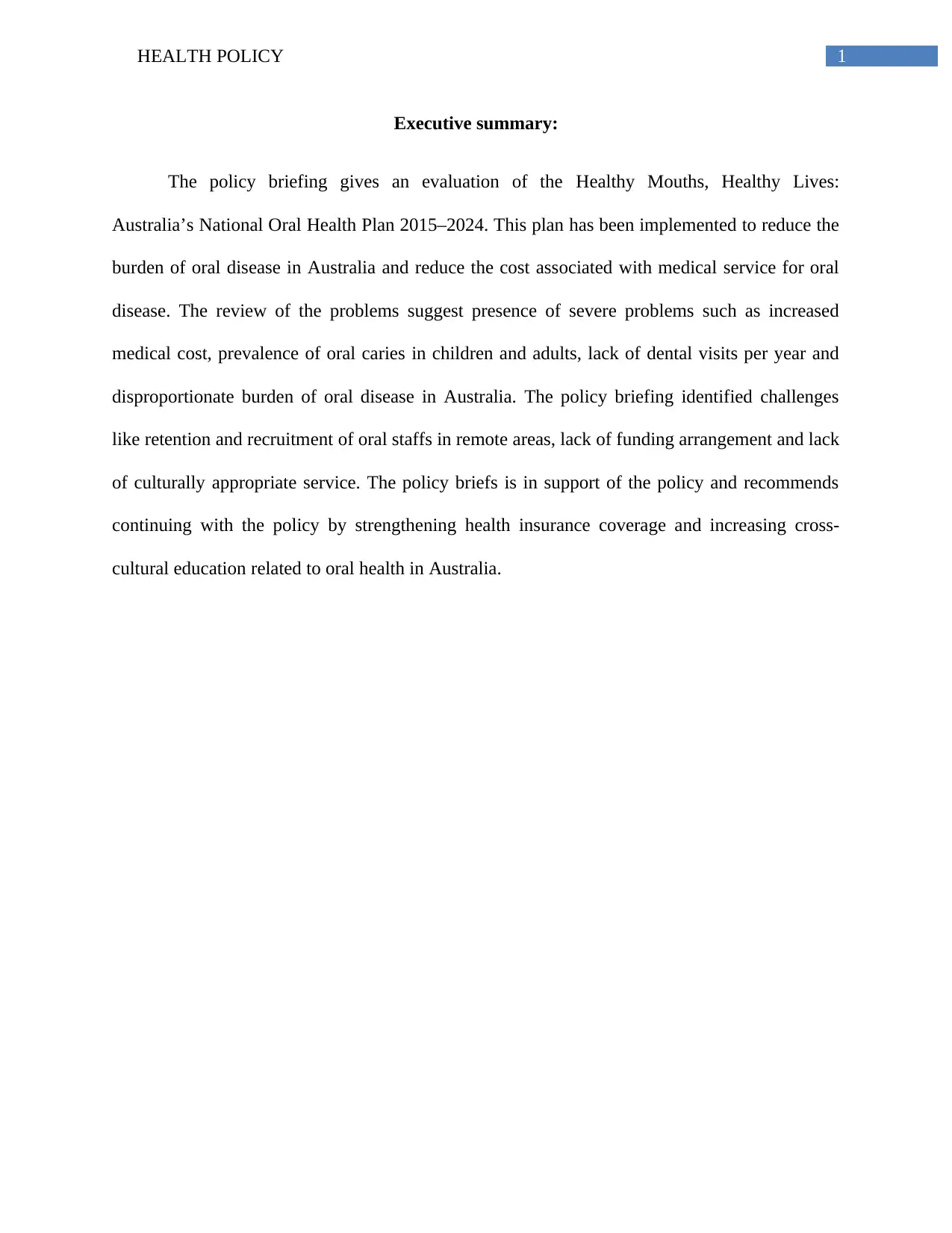
1HEALTH POLICY
Executive summary:
The policy briefing gives an evaluation of the Healthy Mouths, Healthy Lives:
Australia’s National Oral Health Plan 2015–2024. This plan has been implemented to reduce the
burden of oral disease in Australia and reduce the cost associated with medical service for oral
disease. The review of the problems suggest presence of severe problems such as increased
medical cost, prevalence of oral caries in children and adults, lack of dental visits per year and
disproportionate burden of oral disease in Australia. The policy briefing identified challenges
like retention and recruitment of oral staffs in remote areas, lack of funding arrangement and lack
of culturally appropriate service. The policy briefs is in support of the policy and recommends
continuing with the policy by strengthening health insurance coverage and increasing cross-
cultural education related to oral health in Australia.
Executive summary:
The policy briefing gives an evaluation of the Healthy Mouths, Healthy Lives:
Australia’s National Oral Health Plan 2015–2024. This plan has been implemented to reduce the
burden of oral disease in Australia and reduce the cost associated with medical service for oral
disease. The review of the problems suggest presence of severe problems such as increased
medical cost, prevalence of oral caries in children and adults, lack of dental visits per year and
disproportionate burden of oral disease in Australia. The policy briefing identified challenges
like retention and recruitment of oral staffs in remote areas, lack of funding arrangement and lack
of culturally appropriate service. The policy briefs is in support of the policy and recommends
continuing with the policy by strengthening health insurance coverage and increasing cross-
cultural education related to oral health in Australia.
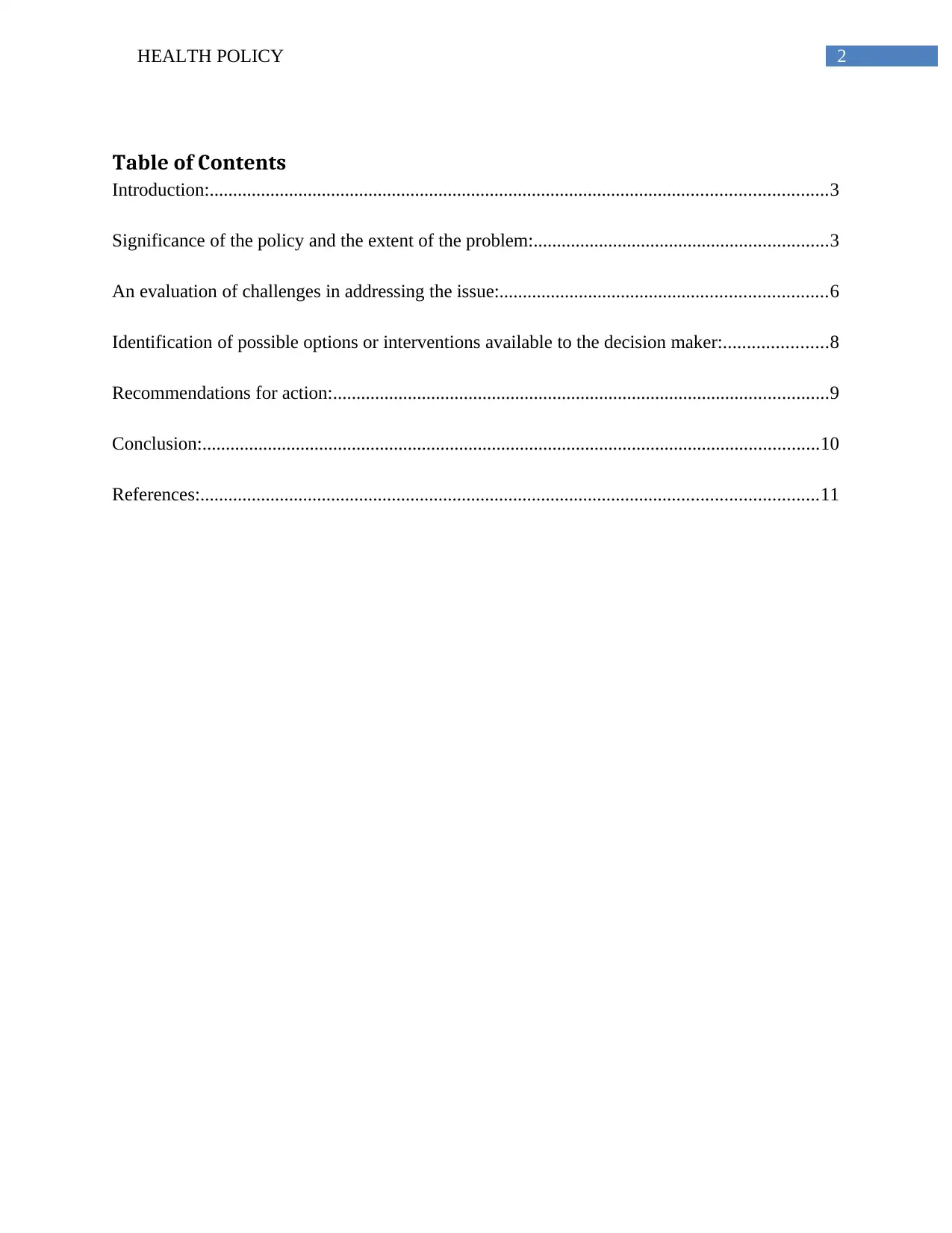
2HEALTH POLICY
Table of Contents
Introduction:....................................................................................................................................3
Significance of the policy and the extent of the problem:...............................................................3
An evaluation of challenges in addressing the issue:......................................................................6
Identification of possible options or interventions available to the decision maker:......................8
Recommendations for action:..........................................................................................................9
Conclusion:....................................................................................................................................10
References:....................................................................................................................................11
Table of Contents
Introduction:....................................................................................................................................3
Significance of the policy and the extent of the problem:...............................................................3
An evaluation of challenges in addressing the issue:......................................................................6
Identification of possible options or interventions available to the decision maker:......................8
Recommendations for action:..........................................................................................................9
Conclusion:....................................................................................................................................10
References:....................................................................................................................................11
⊘ This is a preview!⊘
Do you want full access?
Subscribe today to unlock all pages.

Trusted by 1+ million students worldwide
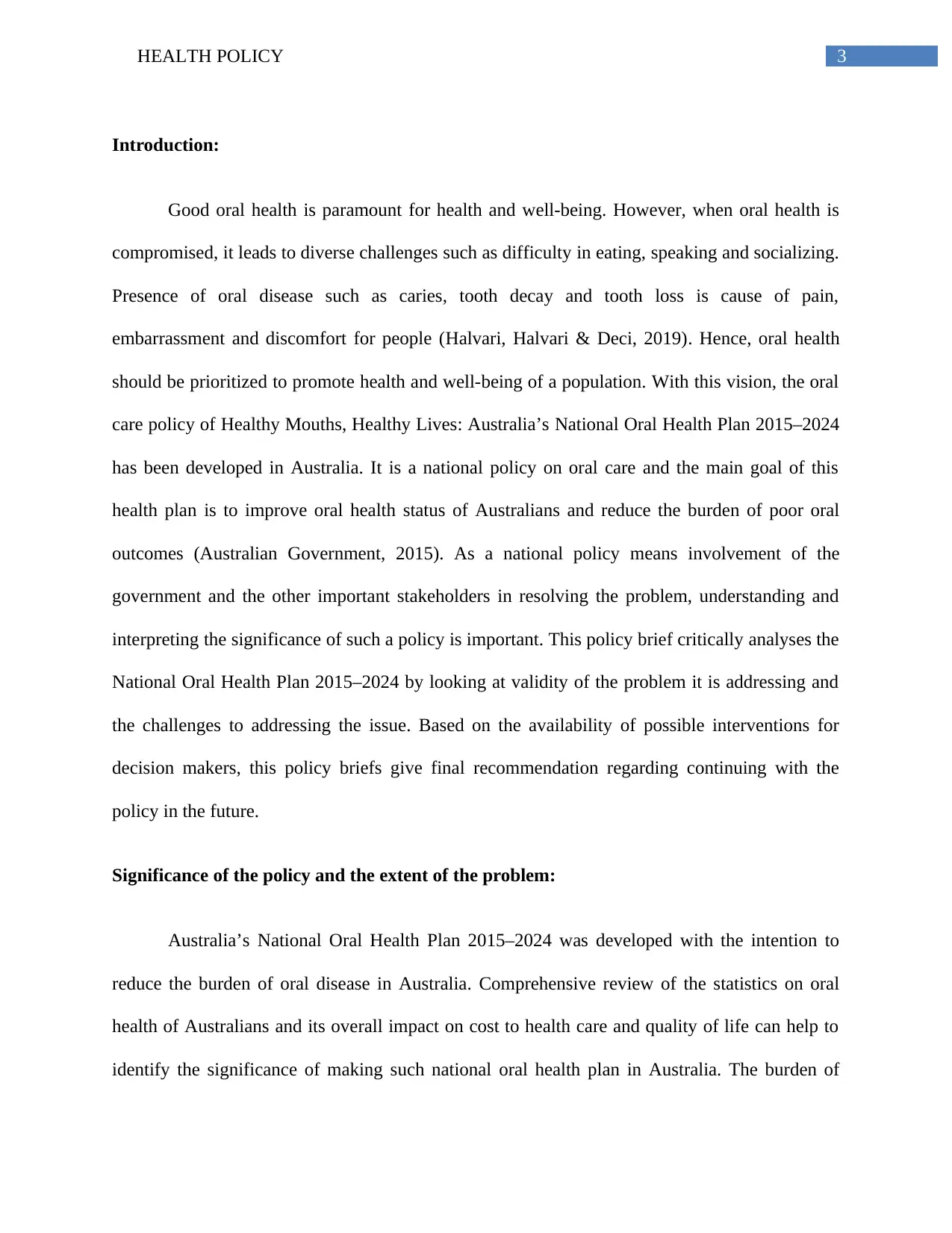
3HEALTH POLICY
Introduction:
Good oral health is paramount for health and well-being. However, when oral health is
compromised, it leads to diverse challenges such as difficulty in eating, speaking and socializing.
Presence of oral disease such as caries, tooth decay and tooth loss is cause of pain,
embarrassment and discomfort for people (Halvari, Halvari & Deci, 2019). Hence, oral health
should be prioritized to promote health and well-being of a population. With this vision, the oral
care policy of Healthy Mouths, Healthy Lives: Australia’s National Oral Health Plan 2015–2024
has been developed in Australia. It is a national policy on oral care and the main goal of this
health plan is to improve oral health status of Australians and reduce the burden of poor oral
outcomes (Australian Government, 2015). As a national policy means involvement of the
government and the other important stakeholders in resolving the problem, understanding and
interpreting the significance of such a policy is important. This policy brief critically analyses the
National Oral Health Plan 2015–2024 by looking at validity of the problem it is addressing and
the challenges to addressing the issue. Based on the availability of possible interventions for
decision makers, this policy briefs give final recommendation regarding continuing with the
policy in the future.
Significance of the policy and the extent of the problem:
Australia’s National Oral Health Plan 2015–2024 was developed with the intention to
reduce the burden of oral disease in Australia. Comprehensive review of the statistics on oral
health of Australians and its overall impact on cost to health care and quality of life can help to
identify the significance of making such national oral health plan in Australia. The burden of
Introduction:
Good oral health is paramount for health and well-being. However, when oral health is
compromised, it leads to diverse challenges such as difficulty in eating, speaking and socializing.
Presence of oral disease such as caries, tooth decay and tooth loss is cause of pain,
embarrassment and discomfort for people (Halvari, Halvari & Deci, 2019). Hence, oral health
should be prioritized to promote health and well-being of a population. With this vision, the oral
care policy of Healthy Mouths, Healthy Lives: Australia’s National Oral Health Plan 2015–2024
has been developed in Australia. It is a national policy on oral care and the main goal of this
health plan is to improve oral health status of Australians and reduce the burden of poor oral
outcomes (Australian Government, 2015). As a national policy means involvement of the
government and the other important stakeholders in resolving the problem, understanding and
interpreting the significance of such a policy is important. This policy brief critically analyses the
National Oral Health Plan 2015–2024 by looking at validity of the problem it is addressing and
the challenges to addressing the issue. Based on the availability of possible interventions for
decision makers, this policy briefs give final recommendation regarding continuing with the
policy in the future.
Significance of the policy and the extent of the problem:
Australia’s National Oral Health Plan 2015–2024 was developed with the intention to
reduce the burden of oral disease in Australia. Comprehensive review of the statistics on oral
health of Australians and its overall impact on cost to health care and quality of life can help to
identify the significance of making such national oral health plan in Australia. The burden of
Paraphrase This Document
Need a fresh take? Get an instant paraphrase of this document with our AI Paraphraser
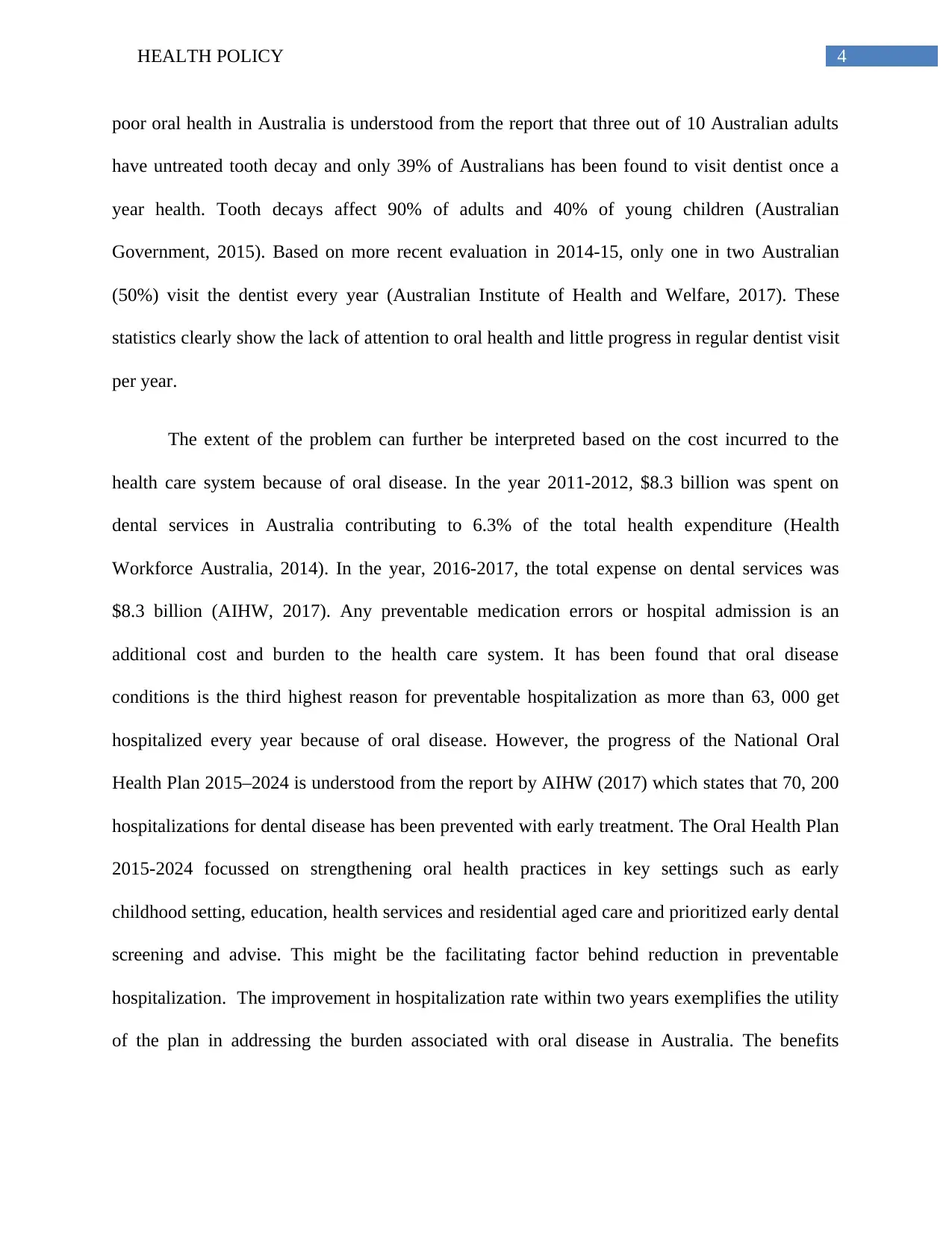
4HEALTH POLICY
poor oral health in Australia is understood from the report that three out of 10 Australian adults
have untreated tooth decay and only 39% of Australians has been found to visit dentist once a
year health. Tooth decays affect 90% of adults and 40% of young children (Australian
Government, 2015). Based on more recent evaluation in 2014-15, only one in two Australian
(50%) visit the dentist every year (Australian Institute of Health and Welfare, 2017). These
statistics clearly show the lack of attention to oral health and little progress in regular dentist visit
per year.
The extent of the problem can further be interpreted based on the cost incurred to the
health care system because of oral disease. In the year 2011-2012, $8.3 billion was spent on
dental services in Australia contributing to 6.3% of the total health expenditure (Health
Workforce Australia, 2014). In the year, 2016-2017, the total expense on dental services was
$8.3 billion (AIHW, 2017). Any preventable medication errors or hospital admission is an
additional cost and burden to the health care system. It has been found that oral disease
conditions is the third highest reason for preventable hospitalization as more than 63, 000 get
hospitalized every year because of oral disease. However, the progress of the National Oral
Health Plan 2015–2024 is understood from the report by AIHW (2017) which states that 70, 200
hospitalizations for dental disease has been prevented with early treatment. The Oral Health Plan
2015-2024 focussed on strengthening oral health practices in key settings such as early
childhood setting, education, health services and residential aged care and prioritized early dental
screening and advise. This might be the facilitating factor behind reduction in preventable
hospitalization. The improvement in hospitalization rate within two years exemplifies the utility
of the plan in addressing the burden associated with oral disease in Australia. The benefits
poor oral health in Australia is understood from the report that three out of 10 Australian adults
have untreated tooth decay and only 39% of Australians has been found to visit dentist once a
year health. Tooth decays affect 90% of adults and 40% of young children (Australian
Government, 2015). Based on more recent evaluation in 2014-15, only one in two Australian
(50%) visit the dentist every year (Australian Institute of Health and Welfare, 2017). These
statistics clearly show the lack of attention to oral health and little progress in regular dentist visit
per year.
The extent of the problem can further be interpreted based on the cost incurred to the
health care system because of oral disease. In the year 2011-2012, $8.3 billion was spent on
dental services in Australia contributing to 6.3% of the total health expenditure (Health
Workforce Australia, 2014). In the year, 2016-2017, the total expense on dental services was
$8.3 billion (AIHW, 2017). Any preventable medication errors or hospital admission is an
additional cost and burden to the health care system. It has been found that oral disease
conditions is the third highest reason for preventable hospitalization as more than 63, 000 get
hospitalized every year because of oral disease. However, the progress of the National Oral
Health Plan 2015–2024 is understood from the report by AIHW (2017) which states that 70, 200
hospitalizations for dental disease has been prevented with early treatment. The Oral Health Plan
2015-2024 focussed on strengthening oral health practices in key settings such as early
childhood setting, education, health services and residential aged care and prioritized early dental
screening and advise. This might be the facilitating factor behind reduction in preventable
hospitalization. The improvement in hospitalization rate within two years exemplifies the utility
of the plan in addressing the burden associated with oral disease in Australia. The benefits
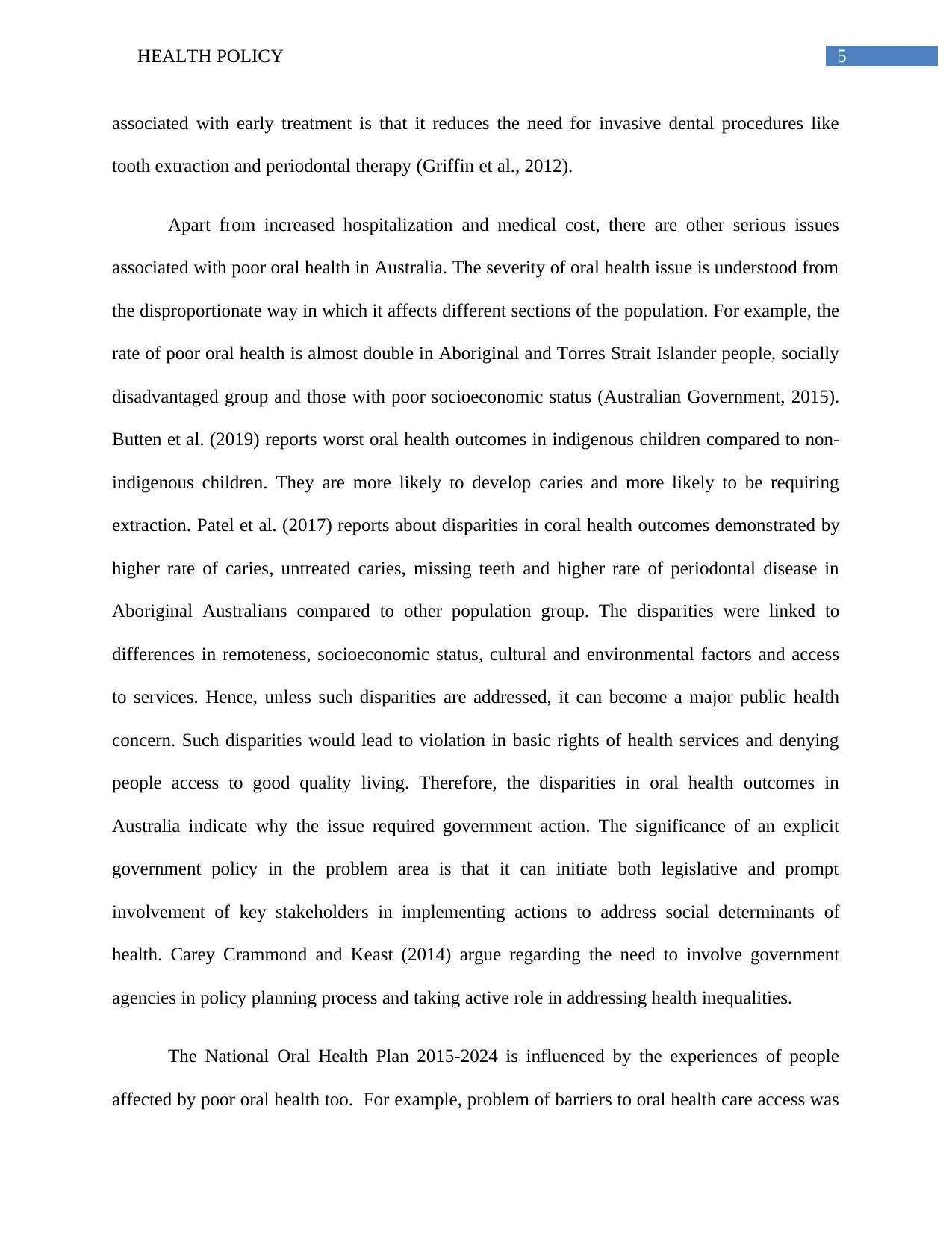
5HEALTH POLICY
associated with early treatment is that it reduces the need for invasive dental procedures like
tooth extraction and periodontal therapy (Griffin et al., 2012).
Apart from increased hospitalization and medical cost, there are other serious issues
associated with poor oral health in Australia. The severity of oral health issue is understood from
the disproportionate way in which it affects different sections of the population. For example, the
rate of poor oral health is almost double in Aboriginal and Torres Strait Islander people, socially
disadvantaged group and those with poor socioeconomic status (Australian Government, 2015).
Butten et al. (2019) reports worst oral health outcomes in indigenous children compared to non-
indigenous children. They are more likely to develop caries and more likely to be requiring
extraction. Patel et al. (2017) reports about disparities in coral health outcomes demonstrated by
higher rate of caries, untreated caries, missing teeth and higher rate of periodontal disease in
Aboriginal Australians compared to other population group. The disparities were linked to
differences in remoteness, socioeconomic status, cultural and environmental factors and access
to services. Hence, unless such disparities are addressed, it can become a major public health
concern. Such disparities would lead to violation in basic rights of health services and denying
people access to good quality living. Therefore, the disparities in oral health outcomes in
Australia indicate why the issue required government action. The significance of an explicit
government policy in the problem area is that it can initiate both legislative and prompt
involvement of key stakeholders in implementing actions to address social determinants of
health. Carey Crammond and Keast (2014) argue regarding the need to involve government
agencies in policy planning process and taking active role in addressing health inequalities.
The National Oral Health Plan 2015-2024 is influenced by the experiences of people
affected by poor oral health too. For example, problem of barriers to oral health care access was
associated with early treatment is that it reduces the need for invasive dental procedures like
tooth extraction and periodontal therapy (Griffin et al., 2012).
Apart from increased hospitalization and medical cost, there are other serious issues
associated with poor oral health in Australia. The severity of oral health issue is understood from
the disproportionate way in which it affects different sections of the population. For example, the
rate of poor oral health is almost double in Aboriginal and Torres Strait Islander people, socially
disadvantaged group and those with poor socioeconomic status (Australian Government, 2015).
Butten et al. (2019) reports worst oral health outcomes in indigenous children compared to non-
indigenous children. They are more likely to develop caries and more likely to be requiring
extraction. Patel et al. (2017) reports about disparities in coral health outcomes demonstrated by
higher rate of caries, untreated caries, missing teeth and higher rate of periodontal disease in
Aboriginal Australians compared to other population group. The disparities were linked to
differences in remoteness, socioeconomic status, cultural and environmental factors and access
to services. Hence, unless such disparities are addressed, it can become a major public health
concern. Such disparities would lead to violation in basic rights of health services and denying
people access to good quality living. Therefore, the disparities in oral health outcomes in
Australia indicate why the issue required government action. The significance of an explicit
government policy in the problem area is that it can initiate both legislative and prompt
involvement of key stakeholders in implementing actions to address social determinants of
health. Carey Crammond and Keast (2014) argue regarding the need to involve government
agencies in policy planning process and taking active role in addressing health inequalities.
The National Oral Health Plan 2015-2024 is influenced by the experiences of people
affected by poor oral health too. For example, problem of barriers to oral health care access was
⊘ This is a preview!⊘
Do you want full access?
Subscribe today to unlock all pages.

Trusted by 1+ million students worldwide
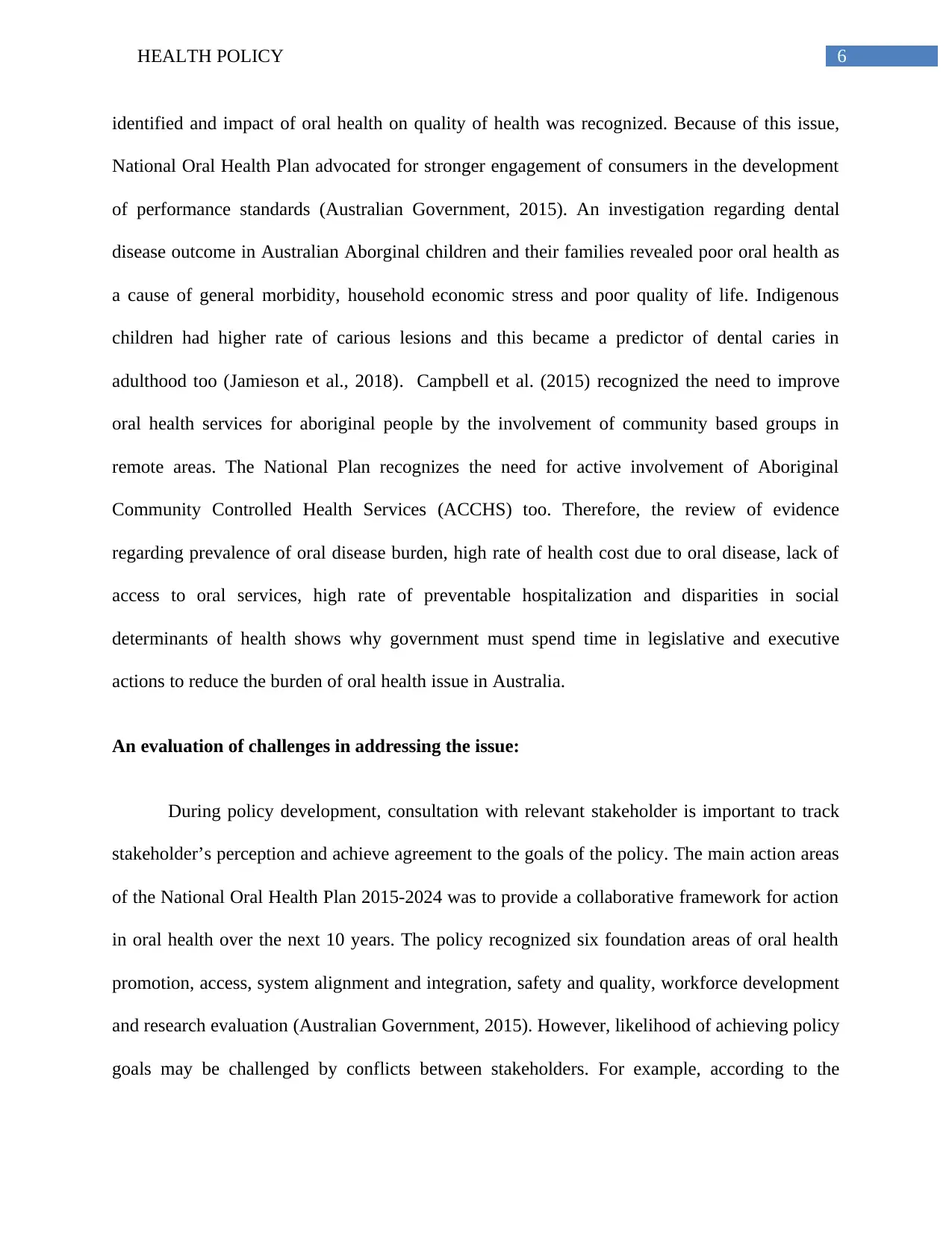
6HEALTH POLICY
identified and impact of oral health on quality of health was recognized. Because of this issue,
National Oral Health Plan advocated for stronger engagement of consumers in the development
of performance standards (Australian Government, 2015). An investigation regarding dental
disease outcome in Australian Aborginal children and their families revealed poor oral health as
a cause of general morbidity, household economic stress and poor quality of life. Indigenous
children had higher rate of carious lesions and this became a predictor of dental caries in
adulthood too (Jamieson et al., 2018). Campbell et al. (2015) recognized the need to improve
oral health services for aboriginal people by the involvement of community based groups in
remote areas. The National Plan recognizes the need for active involvement of Aboriginal
Community Controlled Health Services (ACCHS) too. Therefore, the review of evidence
regarding prevalence of oral disease burden, high rate of health cost due to oral disease, lack of
access to oral services, high rate of preventable hospitalization and disparities in social
determinants of health shows why government must spend time in legislative and executive
actions to reduce the burden of oral health issue in Australia.
An evaluation of challenges in addressing the issue:
During policy development, consultation with relevant stakeholder is important to track
stakeholder’s perception and achieve agreement to the goals of the policy. The main action areas
of the National Oral Health Plan 2015-2024 was to provide a collaborative framework for action
in oral health over the next 10 years. The policy recognized six foundation areas of oral health
promotion, access, system alignment and integration, safety and quality, workforce development
and research evaluation (Australian Government, 2015). However, likelihood of achieving policy
goals may be challenged by conflicts between stakeholders. For example, according to the
identified and impact of oral health on quality of health was recognized. Because of this issue,
National Oral Health Plan advocated for stronger engagement of consumers in the development
of performance standards (Australian Government, 2015). An investigation regarding dental
disease outcome in Australian Aborginal children and their families revealed poor oral health as
a cause of general morbidity, household economic stress and poor quality of life. Indigenous
children had higher rate of carious lesions and this became a predictor of dental caries in
adulthood too (Jamieson et al., 2018). Campbell et al. (2015) recognized the need to improve
oral health services for aboriginal people by the involvement of community based groups in
remote areas. The National Plan recognizes the need for active involvement of Aboriginal
Community Controlled Health Services (ACCHS) too. Therefore, the review of evidence
regarding prevalence of oral disease burden, high rate of health cost due to oral disease, lack of
access to oral services, high rate of preventable hospitalization and disparities in social
determinants of health shows why government must spend time in legislative and executive
actions to reduce the burden of oral health issue in Australia.
An evaluation of challenges in addressing the issue:
During policy development, consultation with relevant stakeholder is important to track
stakeholder’s perception and achieve agreement to the goals of the policy. The main action areas
of the National Oral Health Plan 2015-2024 was to provide a collaborative framework for action
in oral health over the next 10 years. The policy recognized six foundation areas of oral health
promotion, access, system alignment and integration, safety and quality, workforce development
and research evaluation (Australian Government, 2015). However, likelihood of achieving policy
goals may be challenged by conflicts between stakeholders. For example, according to the
Paraphrase This Document
Need a fresh take? Get an instant paraphrase of this document with our AI Paraphraser
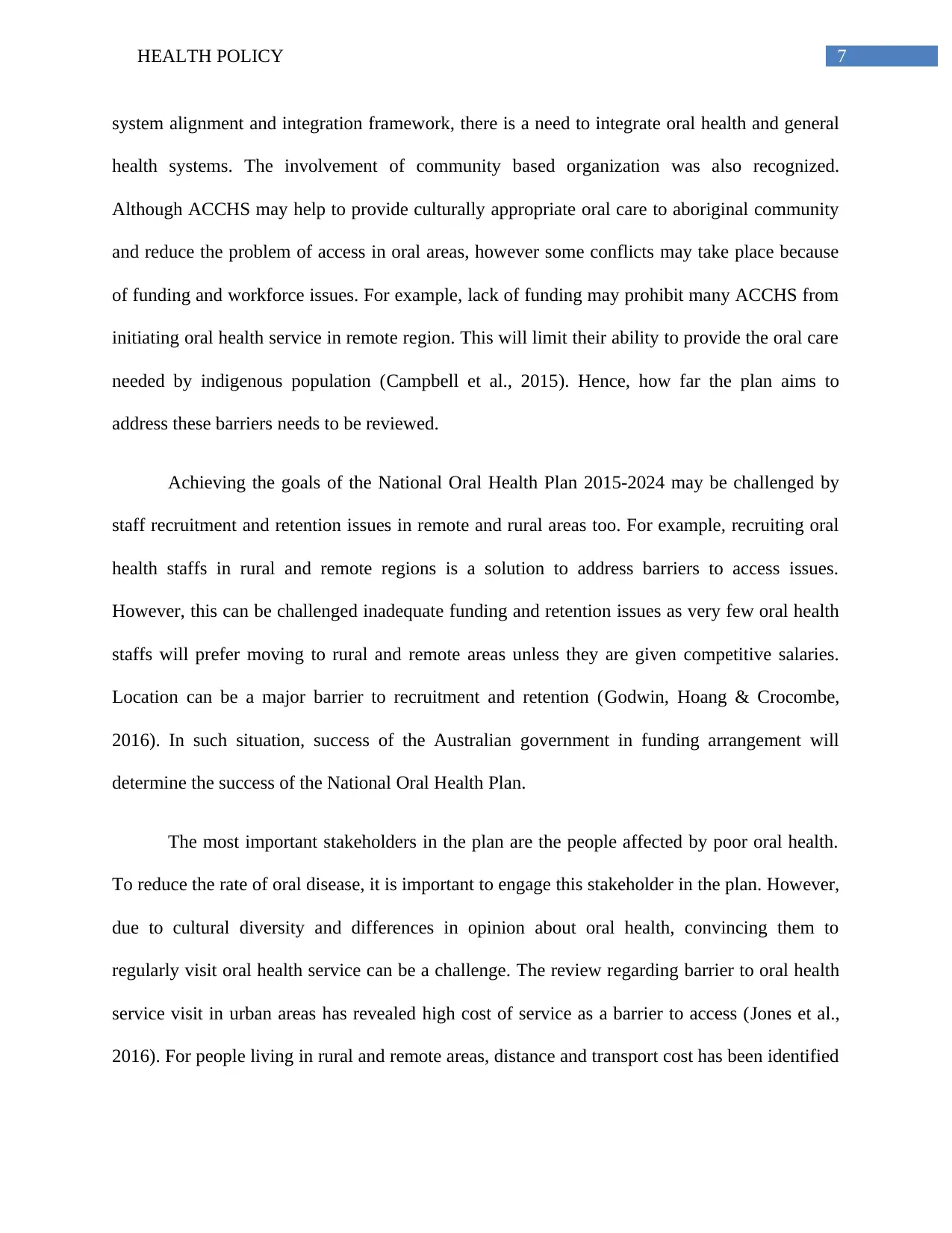
7HEALTH POLICY
system alignment and integration framework, there is a need to integrate oral health and general
health systems. The involvement of community based organization was also recognized.
Although ACCHS may help to provide culturally appropriate oral care to aboriginal community
and reduce the problem of access in oral areas, however some conflicts may take place because
of funding and workforce issues. For example, lack of funding may prohibit many ACCHS from
initiating oral health service in remote region. This will limit their ability to provide the oral care
needed by indigenous population (Campbell et al., 2015). Hence, how far the plan aims to
address these barriers needs to be reviewed.
Achieving the goals of the National Oral Health Plan 2015-2024 may be challenged by
staff recruitment and retention issues in remote and rural areas too. For example, recruiting oral
health staffs in rural and remote regions is a solution to address barriers to access issues.
However, this can be challenged inadequate funding and retention issues as very few oral health
staffs will prefer moving to rural and remote areas unless they are given competitive salaries.
Location can be a major barrier to recruitment and retention (Godwin, Hoang & Crocombe,
2016). In such situation, success of the Australian government in funding arrangement will
determine the success of the National Oral Health Plan.
The most important stakeholders in the plan are the people affected by poor oral health.
To reduce the rate of oral disease, it is important to engage this stakeholder in the plan. However,
due to cultural diversity and differences in opinion about oral health, convincing them to
regularly visit oral health service can be a challenge. The review regarding barrier to oral health
service visit in urban areas has revealed high cost of service as a barrier to access (Jones et al.,
2016). For people living in rural and remote areas, distance and transport cost has been identified
system alignment and integration framework, there is a need to integrate oral health and general
health systems. The involvement of community based organization was also recognized.
Although ACCHS may help to provide culturally appropriate oral care to aboriginal community
and reduce the problem of access in oral areas, however some conflicts may take place because
of funding and workforce issues. For example, lack of funding may prohibit many ACCHS from
initiating oral health service in remote region. This will limit their ability to provide the oral care
needed by indigenous population (Campbell et al., 2015). Hence, how far the plan aims to
address these barriers needs to be reviewed.
Achieving the goals of the National Oral Health Plan 2015-2024 may be challenged by
staff recruitment and retention issues in remote and rural areas too. For example, recruiting oral
health staffs in rural and remote regions is a solution to address barriers to access issues.
However, this can be challenged inadequate funding and retention issues as very few oral health
staffs will prefer moving to rural and remote areas unless they are given competitive salaries.
Location can be a major barrier to recruitment and retention (Godwin, Hoang & Crocombe,
2016). In such situation, success of the Australian government in funding arrangement will
determine the success of the National Oral Health Plan.
The most important stakeholders in the plan are the people affected by poor oral health.
To reduce the rate of oral disease, it is important to engage this stakeholder in the plan. However,
due to cultural diversity and differences in opinion about oral health, convincing them to
regularly visit oral health service can be a challenge. The review regarding barrier to oral health
service visit in urban areas has revealed high cost of service as a barrier to access (Jones et al.,
2016). For people living in rural and remote areas, distance and transport cost has been identified
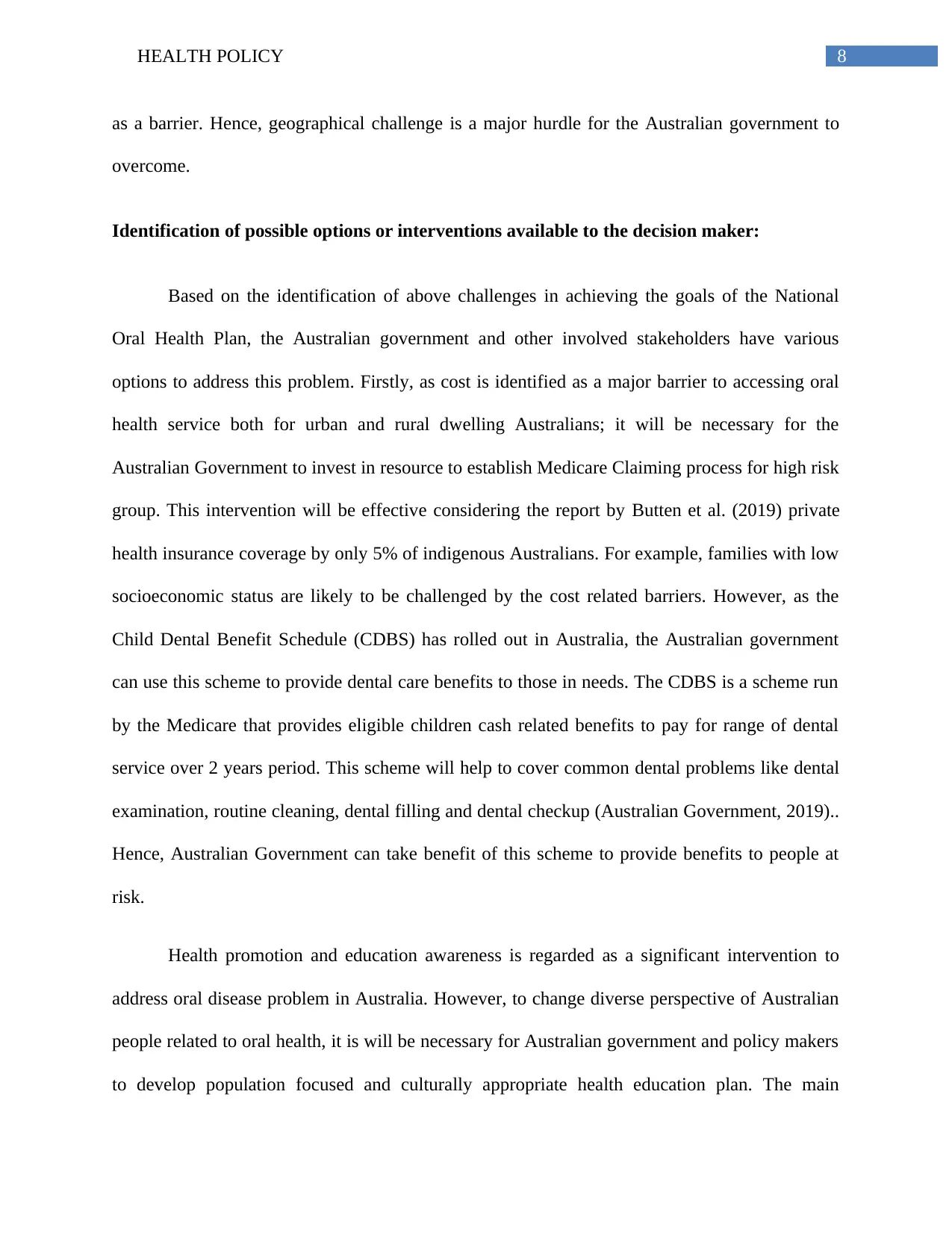
8HEALTH POLICY
as a barrier. Hence, geographical challenge is a major hurdle for the Australian government to
overcome.
Identification of possible options or interventions available to the decision maker:
Based on the identification of above challenges in achieving the goals of the National
Oral Health Plan, the Australian government and other involved stakeholders have various
options to address this problem. Firstly, as cost is identified as a major barrier to accessing oral
health service both for urban and rural dwelling Australians; it will be necessary for the
Australian Government to invest in resource to establish Medicare Claiming process for high risk
group. This intervention will be effective considering the report by Butten et al. (2019) private
health insurance coverage by only 5% of indigenous Australians. For example, families with low
socioeconomic status are likely to be challenged by the cost related barriers. However, as the
Child Dental Benefit Schedule (CDBS) has rolled out in Australia, the Australian government
can use this scheme to provide dental care benefits to those in needs. The CDBS is a scheme run
by the Medicare that provides eligible children cash related benefits to pay for range of dental
service over 2 years period. This scheme will help to cover common dental problems like dental
examination, routine cleaning, dental filling and dental checkup (Australian Government, 2019)..
Hence, Australian Government can take benefit of this scheme to provide benefits to people at
risk.
Health promotion and education awareness is regarded as a significant intervention to
address oral disease problem in Australia. However, to change diverse perspective of Australian
people related to oral health, it is will be necessary for Australian government and policy makers
to develop population focused and culturally appropriate health education plan. The main
as a barrier. Hence, geographical challenge is a major hurdle for the Australian government to
overcome.
Identification of possible options or interventions available to the decision maker:
Based on the identification of above challenges in achieving the goals of the National
Oral Health Plan, the Australian government and other involved stakeholders have various
options to address this problem. Firstly, as cost is identified as a major barrier to accessing oral
health service both for urban and rural dwelling Australians; it will be necessary for the
Australian Government to invest in resource to establish Medicare Claiming process for high risk
group. This intervention will be effective considering the report by Butten et al. (2019) private
health insurance coverage by only 5% of indigenous Australians. For example, families with low
socioeconomic status are likely to be challenged by the cost related barriers. However, as the
Child Dental Benefit Schedule (CDBS) has rolled out in Australia, the Australian government
can use this scheme to provide dental care benefits to those in needs. The CDBS is a scheme run
by the Medicare that provides eligible children cash related benefits to pay for range of dental
service over 2 years period. This scheme will help to cover common dental problems like dental
examination, routine cleaning, dental filling and dental checkup (Australian Government, 2019)..
Hence, Australian Government can take benefit of this scheme to provide benefits to people at
risk.
Health promotion and education awareness is regarded as a significant intervention to
address oral disease problem in Australia. However, to change diverse perspective of Australian
people related to oral health, it is will be necessary for Australian government and policy makers
to develop population focused and culturally appropriate health education plan. The main
⊘ This is a preview!⊘
Do you want full access?
Subscribe today to unlock all pages.

Trusted by 1+ million students worldwide
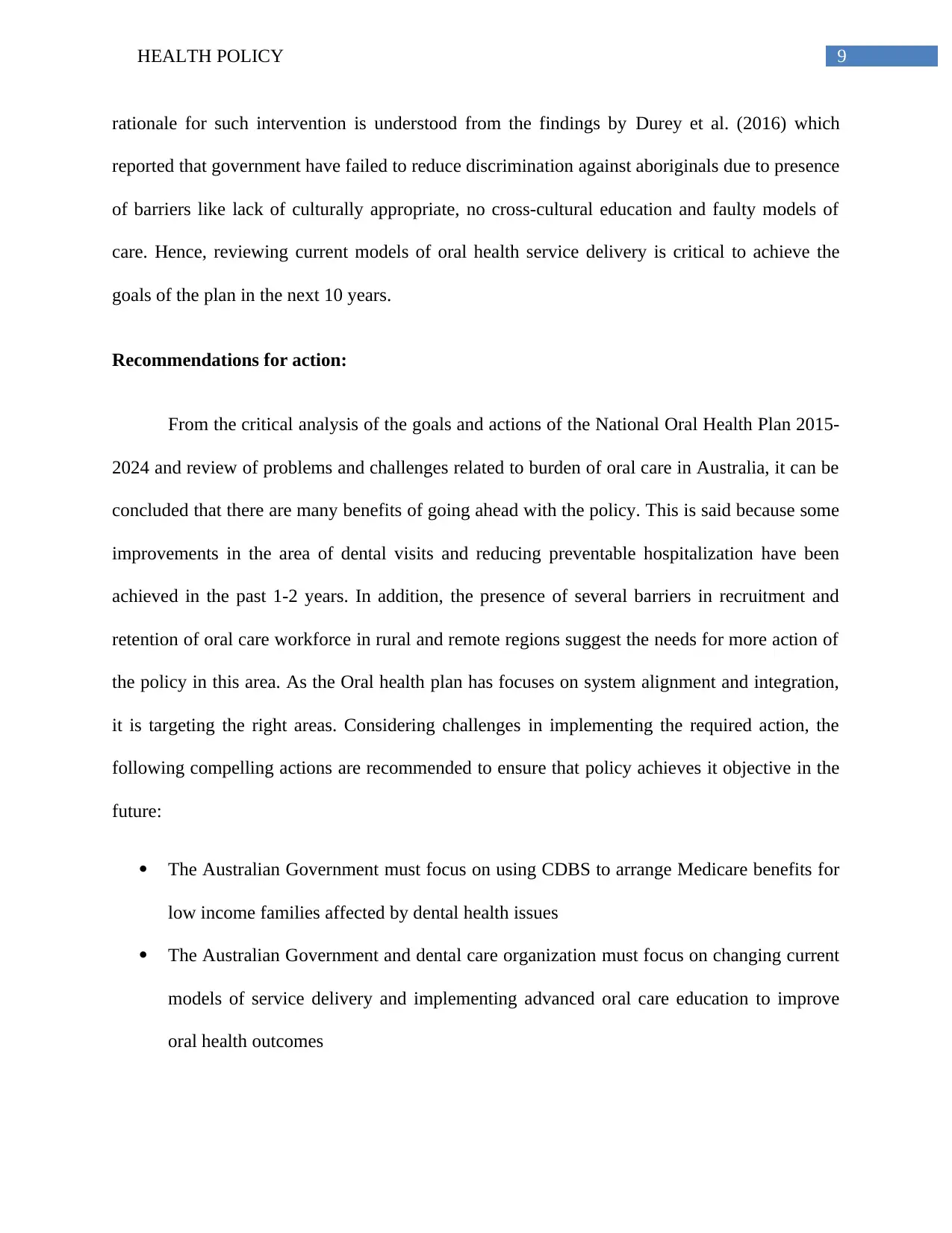
9HEALTH POLICY
rationale for such intervention is understood from the findings by Durey et al. (2016) which
reported that government have failed to reduce discrimination against aboriginals due to presence
of barriers like lack of culturally appropriate, no cross-cultural education and faulty models of
care. Hence, reviewing current models of oral health service delivery is critical to achieve the
goals of the plan in the next 10 years.
Recommendations for action:
From the critical analysis of the goals and actions of the National Oral Health Plan 2015-
2024 and review of problems and challenges related to burden of oral care in Australia, it can be
concluded that there are many benefits of going ahead with the policy. This is said because some
improvements in the area of dental visits and reducing preventable hospitalization have been
achieved in the past 1-2 years. In addition, the presence of several barriers in recruitment and
retention of oral care workforce in rural and remote regions suggest the needs for more action of
the policy in this area. As the Oral health plan has focuses on system alignment and integration,
it is targeting the right areas. Considering challenges in implementing the required action, the
following compelling actions are recommended to ensure that policy achieves it objective in the
future:
The Australian Government must focus on using CDBS to arrange Medicare benefits for
low income families affected by dental health issues
The Australian Government and dental care organization must focus on changing current
models of service delivery and implementing advanced oral care education to improve
oral health outcomes
rationale for such intervention is understood from the findings by Durey et al. (2016) which
reported that government have failed to reduce discrimination against aboriginals due to presence
of barriers like lack of culturally appropriate, no cross-cultural education and faulty models of
care. Hence, reviewing current models of oral health service delivery is critical to achieve the
goals of the plan in the next 10 years.
Recommendations for action:
From the critical analysis of the goals and actions of the National Oral Health Plan 2015-
2024 and review of problems and challenges related to burden of oral care in Australia, it can be
concluded that there are many benefits of going ahead with the policy. This is said because some
improvements in the area of dental visits and reducing preventable hospitalization have been
achieved in the past 1-2 years. In addition, the presence of several barriers in recruitment and
retention of oral care workforce in rural and remote regions suggest the needs for more action of
the policy in this area. As the Oral health plan has focuses on system alignment and integration,
it is targeting the right areas. Considering challenges in implementing the required action, the
following compelling actions are recommended to ensure that policy achieves it objective in the
future:
The Australian Government must focus on using CDBS to arrange Medicare benefits for
low income families affected by dental health issues
The Australian Government and dental care organization must focus on changing current
models of service delivery and implementing advanced oral care education to improve
oral health outcomes
Paraphrase This Document
Need a fresh take? Get an instant paraphrase of this document with our AI Paraphraser
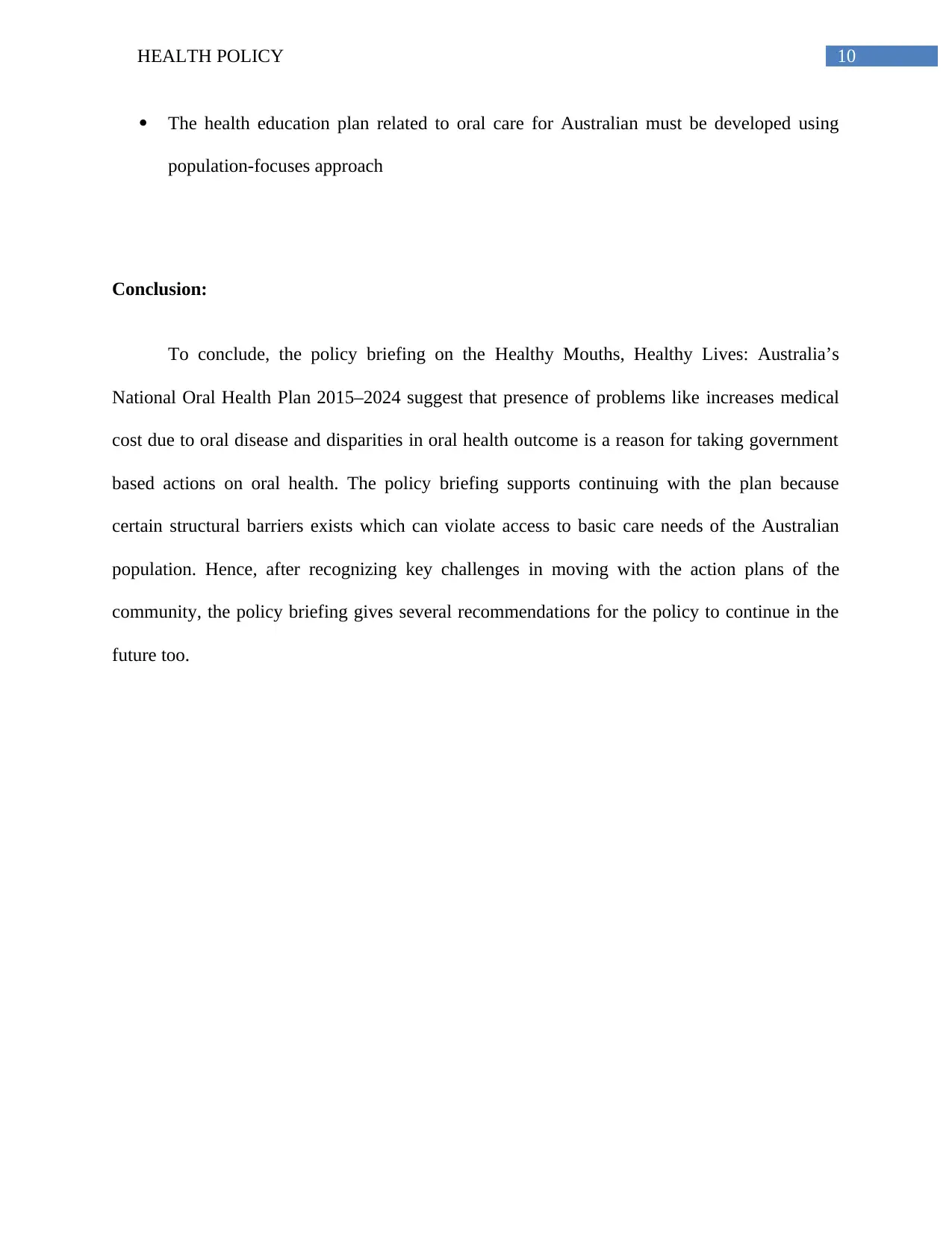
10HEALTH POLICY
The health education plan related to oral care for Australian must be developed using
population-focuses approach
Conclusion:
To conclude, the policy briefing on the Healthy Mouths, Healthy Lives: Australia’s
National Oral Health Plan 2015–2024 suggest that presence of problems like increases medical
cost due to oral disease and disparities in oral health outcome is a reason for taking government
based actions on oral health. The policy briefing supports continuing with the plan because
certain structural barriers exists which can violate access to basic care needs of the Australian
population. Hence, after recognizing key challenges in moving with the action plans of the
community, the policy briefing gives several recommendations for the policy to continue in the
future too.
The health education plan related to oral care for Australian must be developed using
population-focuses approach
Conclusion:
To conclude, the policy briefing on the Healthy Mouths, Healthy Lives: Australia’s
National Oral Health Plan 2015–2024 suggest that presence of problems like increases medical
cost due to oral disease and disparities in oral health outcome is a reason for taking government
based actions on oral health. The policy briefing supports continuing with the plan because
certain structural barriers exists which can violate access to basic care needs of the Australian
population. Hence, after recognizing key challenges in moving with the action plans of the
community, the policy briefing gives several recommendations for the policy to continue in the
future too.
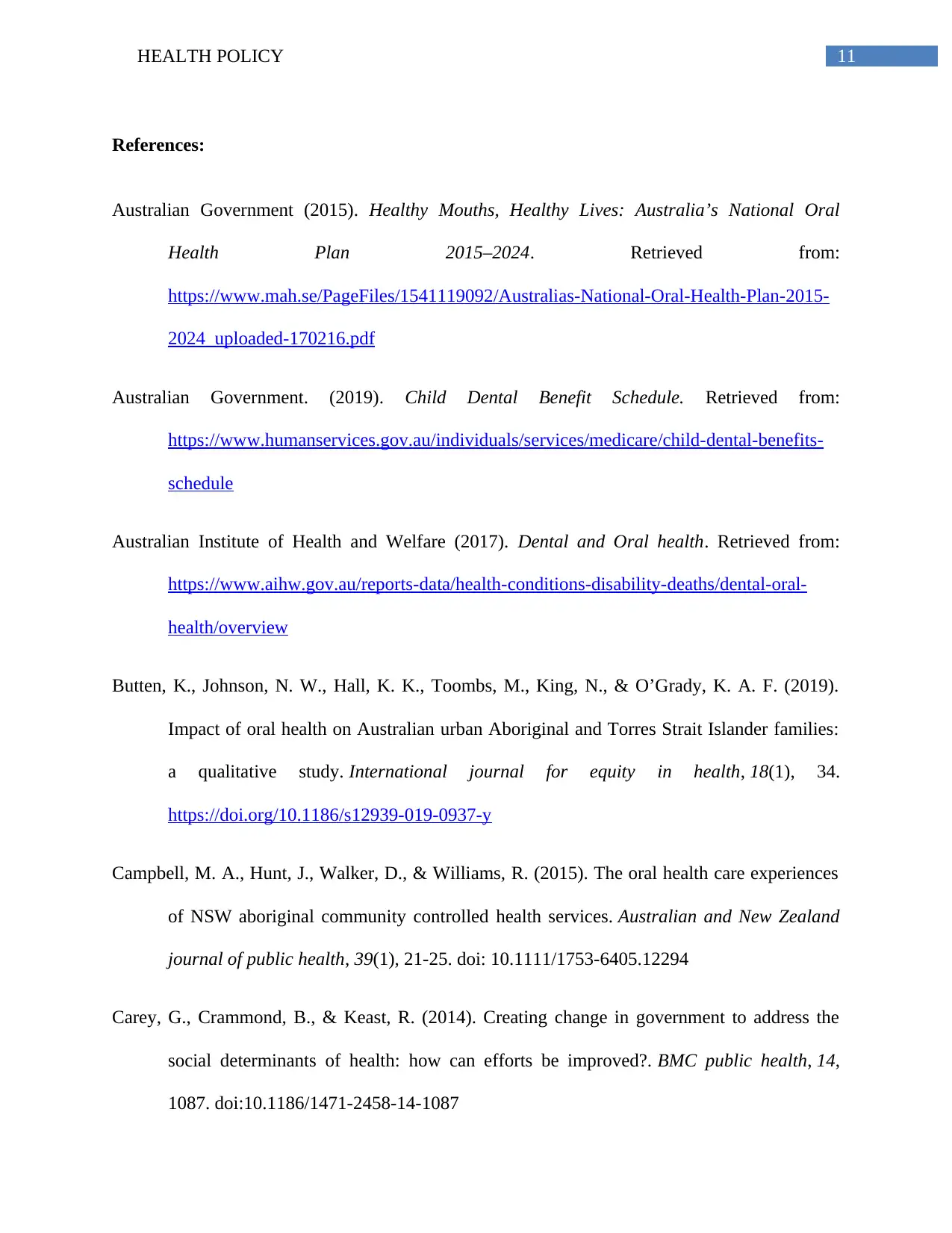
11HEALTH POLICY
References:
Australian Government (2015). Healthy Mouths, Healthy Lives: Australia’s National Oral
Health Plan 2015–2024. Retrieved from:
https://www.mah.se/PageFiles/1541119092/Australias-National-Oral-Health-Plan-2015-
2024_uploaded-170216.pdf
Australian Government. (2019). Child Dental Benefit Schedule. Retrieved from:
https://www.humanservices.gov.au/individuals/services/medicare/child-dental-benefits-
schedule
Australian Institute of Health and Welfare (2017). Dental and Oral health. Retrieved from:
https://www.aihw.gov.au/reports-data/health-conditions-disability-deaths/dental-oral-
health/overview
Butten, K., Johnson, N. W., Hall, K. K., Toombs, M., King, N., & O’Grady, K. A. F. (2019).
Impact of oral health on Australian urban Aboriginal and Torres Strait Islander families:
a qualitative study. International journal for equity in health, 18(1), 34.
https://doi.org/10.1186/s12939-019-0937-y
Campbell, M. A., Hunt, J., Walker, D., & Williams, R. (2015). The oral health care experiences
of NSW aboriginal community controlled health services. Australian and New Zealand
journal of public health, 39(1), 21-25. doi: 10.1111/1753-6405.12294
Carey, G., Crammond, B., & Keast, R. (2014). Creating change in government to address the
social determinants of health: how can efforts be improved?. BMC public health, 14,
1087. doi:10.1186/1471-2458-14-1087
References:
Australian Government (2015). Healthy Mouths, Healthy Lives: Australia’s National Oral
Health Plan 2015–2024. Retrieved from:
https://www.mah.se/PageFiles/1541119092/Australias-National-Oral-Health-Plan-2015-
2024_uploaded-170216.pdf
Australian Government. (2019). Child Dental Benefit Schedule. Retrieved from:
https://www.humanservices.gov.au/individuals/services/medicare/child-dental-benefits-
schedule
Australian Institute of Health and Welfare (2017). Dental and Oral health. Retrieved from:
https://www.aihw.gov.au/reports-data/health-conditions-disability-deaths/dental-oral-
health/overview
Butten, K., Johnson, N. W., Hall, K. K., Toombs, M., King, N., & O’Grady, K. A. F. (2019).
Impact of oral health on Australian urban Aboriginal and Torres Strait Islander families:
a qualitative study. International journal for equity in health, 18(1), 34.
https://doi.org/10.1186/s12939-019-0937-y
Campbell, M. A., Hunt, J., Walker, D., & Williams, R. (2015). The oral health care experiences
of NSW aboriginal community controlled health services. Australian and New Zealand
journal of public health, 39(1), 21-25. doi: 10.1111/1753-6405.12294
Carey, G., Crammond, B., & Keast, R. (2014). Creating change in government to address the
social determinants of health: how can efforts be improved?. BMC public health, 14,
1087. doi:10.1186/1471-2458-14-1087
⊘ This is a preview!⊘
Do you want full access?
Subscribe today to unlock all pages.

Trusted by 1+ million students worldwide
1 out of 14
Related Documents
Your All-in-One AI-Powered Toolkit for Academic Success.
+13062052269
info@desklib.com
Available 24*7 on WhatsApp / Email
![[object Object]](/_next/static/media/star-bottom.7253800d.svg)
Unlock your academic potential
Copyright © 2020–2025 A2Z Services. All Rights Reserved. Developed and managed by ZUCOL.





